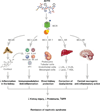The renaissance of corticotropin therapy in proteinuric nephropathies
- PMID: 22143333
- PMCID: PMC3540823
- DOI: 10.1038/nrneph.2011.190
The renaissance of corticotropin therapy in proteinuric nephropathies
Abstract
Refractory nephrotic syndrome continues to be a therapeutic challenge despite advances in immunosuppression and blockade of the renin-angiotensin-aldosterone cascade. Adrenocorticotropic hormone (ACTH), a pituitary neuroimmunoendocrine polypeptide, was widely used in the 1950s as an effective therapy for childhood nephrotic syndrome, but has since been replaced by synthetic glucocorticoid analogues. In addition to controlling steroidogenesis, ACTH also acts as an important physiological agonist of the melanocortin system. Clinical and experimental evidence now suggests that ACTH has antiproteinuric, lipid-lowering and renoprotective properties, which are not fully explained by its steroidogenic effects. ACTH therapy is effective in inducing remission of nephrotic syndrome in patients with a variety of proteinuric nephropathies, even those resistant to steroids and other immunosuppressants. This Perspectives article describes the biophysiology of ACTH, with an emphasis on its melanocortin actions, particularly in renal parenchymal cells, which could potentially explain the therapeutic effects of ACTH in nephrotic glomerulopathies.
Figures



References
-
- Dores RM. Adrenocorticotropic hormone, melanocyte-stimulating hormone, and the melanocortin receptors: revisiting the work of Robert Schwyzer: a thirty-year retrospective. Ann N Y Acad Sci. 2009;1163:93–100. - PubMed
-
- Berg AL, Arnadottir M. ACTH revisited--potential implications for patients with renal disease. Nephrol Dial Transplant. 2000;15:940–942. - PubMed
Publication types
MeSH terms
Substances
Grants and funding
LinkOut - more resources
Full Text Sources
Other Literature Sources
Medical

